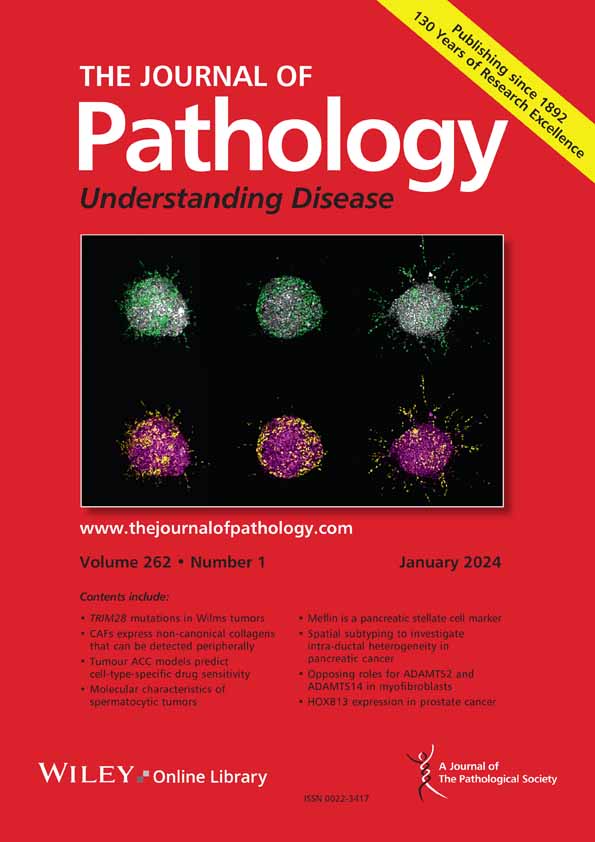A deep-learning model for predicting tyrosine kinase inhibitor response from histology in gastrointestinal stromal tumor.
Xue Kong, Jun Shi, Dongdong Sun, Lanqing Cheng, Can Wu, Zhiguo Jiang, Yushan Zheng, Wei Wang, Haibo Wu
求助PDF
{"title":"A deep-learning model for predicting tyrosine kinase inhibitor response from histology in gastrointestinal stromal tumor.","authors":"Xue Kong, Jun Shi, Dongdong Sun, Lanqing Cheng, Can Wu, Zhiguo Jiang, Yushan Zheng, Wei Wang, Haibo Wu","doi":"10.1002/path.6399","DOIUrl":null,"url":null,"abstract":"<p><p>Over 90% of gastrointestinal stromal tumors (GISTs) harbor mutations in KIT or PDGFRA that can predict response to tyrosine kinase inhibitor (TKI) therapies, as recommended by NCCN (National Comprehensive Cancer Network) guidelines. However, gene sequencing for mutation testing is expensive and time-consuming and is susceptible to a variety of preanalytical factors. To overcome the challenges associated with genetic screening by sequencing, in the current study we developed an artificial intelligence-based deep-learning (DL) model that uses convolutional neural networks (CNN) to analyze digitized hematoxylin and eosin staining in tumor histological sections to predict potential response to imatinib or avapritinib treatment in GIST patients. Assessment with an independent testing set showed that our DL model could predict imatinib sensitivity with an area under the curve (AUC) of 0.902 in case-wise analysis and 0.807 in slide-wise analysis. Case-level AUCs for predicting imatinib-dose-adjustment cases, avapritinib-sensitive cases, and wildtype GISTs were 0.920, 0.958, and 0.776, respectively, while slide-level AUCs for these respective groups were 0.714, 0.922, and 0.886, respectively. Our model showed comparable or better prediction of actual response to TKI than sequencing-based screening (accuracy 0.9286 versus 0.8929; DL model versus sequencing), while predictions of nonresponse to imatinib/avapritinib showed markedly higher accuracy than sequencing (0.7143 versus 0.4286). These results demonstrate the potential of a DL model to improve predictions of treatment response to TKI therapy from histology in GIST patients. © 2025 The Pathological Society of Great Britain and Ireland.</p>","PeriodicalId":232,"journal":{"name":"The Journal of Pathology","volume":" ","pages":""},"PeriodicalIF":5.6000,"publicationDate":"2025-02-14","publicationTypes":"Journal Article","fieldsOfStudy":null,"isOpenAccess":false,"openAccessPdf":"","citationCount":"0","resultStr":null,"platform":"Semanticscholar","paperid":null,"PeriodicalName":"The Journal of Pathology","FirstCategoryId":"3","ListUrlMain":"https://doi.org/10.1002/path.6399","RegionNum":2,"RegionCategory":"医学","ArticlePicture":[],"TitleCN":null,"AbstractTextCN":null,"PMCID":null,"EPubDate":"","PubModel":"","JCR":"Q1","JCRName":"ONCOLOGY","Score":null,"Total":0}
引用次数: 0
引用
批量引用
Abstract
Over 90% of gastrointestinal stromal tumors (GISTs) harbor mutations in KIT or PDGFRA that can predict response to tyrosine kinase inhibitor (TKI) therapies, as recommended by NCCN (National Comprehensive Cancer Network) guidelines. However, gene sequencing for mutation testing is expensive and time-consuming and is susceptible to a variety of preanalytical factors. To overcome the challenges associated with genetic screening by sequencing, in the current study we developed an artificial intelligence-based deep-learning (DL) model that uses convolutional neural networks (CNN) to analyze digitized hematoxylin and eosin staining in tumor histological sections to predict potential response to imatinib or avapritinib treatment in GIST patients. Assessment with an independent testing set showed that our DL model could predict imatinib sensitivity with an area under the curve (AUC) of 0.902 in case-wise analysis and 0.807 in slide-wise analysis. Case-level AUCs for predicting imatinib-dose-adjustment cases, avapritinib-sensitive cases, and wildtype GISTs were 0.920, 0.958, and 0.776, respectively, while slide-level AUCs for these respective groups were 0.714, 0.922, and 0.886, respectively. Our model showed comparable or better prediction of actual response to TKI than sequencing-based screening (accuracy 0.9286 versus 0.8929; DL model versus sequencing), while predictions of nonresponse to imatinib/avapritinib showed markedly higher accuracy than sequencing (0.7143 versus 0.4286). These results demonstrate the potential of a DL model to improve predictions of treatment response to TKI therapy from histology in GIST patients. © 2025 The Pathological Society of Great Britain and Ireland.


